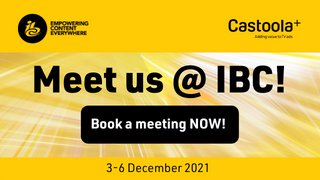An interview with Castoola’s sales director Matej Puhan
Targeted TV advertising is rapidly expanding, but what are the main drivers and what is holding back faster adoption and budget shifts? In this interview, we speak with Matej Puhan, Sales Director at Castoola. With over a decade of experience in the broadcasting industry, Matej shares his insights on the challenges and opportunities facing the industry, the evolution of Castoola, and the future outlook of targeted TV advertising. From the importance of understanding unique market characteristics to the need for a new buying/selling logic for TV advertising inventory, Matej provides valuable insights into the future of TV advertising.
Whether you’re a seasoned industry professional or just starting to explore targeted TV advertising, this interview is a must-read for anyone looking to stay ahead of the game. Let’s jump right in!
What have been the most important lessons you’ve learned in the past five years as you’ve seen targeted TV advertising grow and expand?
Over the past few years, we’ve gained a wealth of insights into the targeted TV advertising space. Although we’ve tackled many topics, I’ll highlight three key areas we’ve focused on.
Firstly, it’s essential to consider each country’s TV ecosystem separately. Advertising is no exception, and what works in one market may not work in another. For example, in Europe, markets can differ significantly from one another. Therefore, additional research is necessary to determine how to approach a specific market.
Secondly, technology has made significant strides in enabling effective targeted TV advertising. However, technology alone does not guarantee a successful business. The market must adopt the technology for revenue to be generated and for solutions to come to life. Unfortunately, the adoption of targeted TV advertising technology in most markets has been slower than expected.
Thirdly, the TV industry has undergone several big changes in recent years, making it an extremely dynamic and challenging environment to grow a successful business. OTT services have emerged as a fast-growing competitor to traditional pay TV providers and their STBs. TV manufacturers with their operating systems are starting to take over the role of STBs as they can influence content discoverability and understand user habits in the same way as IPTV operators.
Change is the only constant in this industry. Hence, it’s challenging to follow different markets as they develop at different speeds, and it’s difficult to predict in which direction each of these markets will develop. In summary, we’ve learned that understanding the unique characteristics of each market is crucial, technology alone does not guarantee success, and being prepared to adapt to industry changes is vital for success in targeted TV advertising.
How has Castoola evolved as a company in the past years, and how have you adapted to the only constant out there – constant change?
Over the years, Castoola has always stayed ahead of the curve by listening to our clients and studying the market’s needs closely. From the early days, when targeted TV advertising was starting to gain traction with HbbTV technology in Europe, to the current landscape with OTT platforms and FAST channels, we have remained committed to meeting our clients’ needs and supporting their business growth. We developed our solutions and services with a deep understanding of our clients’ needs and what is essential for their business growth. Our tech stack is built on both publisher and demand sides, making us one of the leading providers of targeted TV advertising solutions.
Looking back, I am proud of the significant steps we have taken as a company. Our loyal customers, including Warner Bros. Discovery, attest to the quality of our work over the past five years. We have stayed committed to our clients and focused on delivering top-notch services, and it has paid off in our success as a company. We will continue to evolve and adapt to the ever-changing industry to provide our clients with the best solutions for their businesses.
With all the changes in the TV industry, do you think we can predict what the future of TV will look like?
While I can’t predict the future like a soothsayer, I do believe we can make some educated guesses. The big SVOD platforms like Netflix, HBO, and Disney have a lot of interesting content to offer and can build sustainable business models with SVOD, as well as a combination of SVOD+AVOD. However, regardless of the platform, the key to success is having the best user experience and compelling content. We must acknowledge that content is king. Whether it’s linear television, OTT platforms, or FAST channels, people will follow the content they enjoy. So, both traditional broadcasters and new OTT platforms have a good chance of building sustainable businesses as long as they have content that people want to watch, such as live sports events, blockbuster movies, and original local series.
In summary, the future of TV will depend on the ability of the industry to continue producing high-quality content and delivering a great user experience, regardless of the platform or technology used to deliver it.
What are the main drivers, and what is holding back faster adoption and budget shifts towards ATV?
The primary drivers of targeted TV advertising are the emergence of technology and the desire for more effective advertising campaigns on the most significant screen in households.
Many stakeholders are driving this technology forward because they believe it is the future of TV advertising. The increasing consumption of content via streaming platforms has made TV more digital than ever, and this trend is expected to continue. However, there are still several factors holding back faster adoption and budget shifts towards targeted TV advertising. These include issues with measurement, privacy concerns, and the need for a new buying and selling logic for TV advertising inventory.
Key blockers of faster adoption and budget shifts toward targeted TV advertising:
- Measurement is a significant issue, as there is no consensus on how to bring traditional linear TV and new OTT viewing together on the same panel. This is slowing down the transition from less efficient linear TV advertising to a new and more efficient way of serving and tracking ads.
- When it comes to targeting and user data, privacy is a significant concern. Advertisers must obtain user consent to use specific data for targeted advertising. Steps are being taken in the right direction to enable both content-related and targeted ads based on household profiles. Still, privacy is a critical issue that has caused interruptions in online advertising, so everyone is cautious to ensure things are done correctly on TV right from the beginning. This could be slowing down the adoption of targeted TV advertising.
- Finally, there is an evolution happening on the buy side, with some industry experts claiming that this is the only thing that will truly change the TV advertising business. Digital ways of buying inventory, such as programmatic buying, are starting to make their way to the big screen. However, many rules have not yet been established, so all stakeholders must agree on how to move things forward and what they should look like in the future. Although the readiness is there, things will still move slowly due to these blockers.
How do you see the adoption of programmatic advertising on the big screen?
We certainly hear a lot of noise being made around programmatic, but its adoption is not uniform across the world. While we see that a lot of advertising dollars are pushed through programmatic platforms in the US, the rest of the world is only slowly transitioning to programmatic advertising. In general, we are witnessing the chicken-and-egg situation where the demand side is waiting for relevant supply, while supply, on the other hand, is expecting the demand to be there from day one of making their inventory available.
As an “intermediary” in some markets, we have been successful in bringing together or connecting supply and demand partners. However, both sides will need to be proactive and manage their expectations to promote the adoption of programmatic advertising on the big screen.
How do clients typically view Castoola and your solutions and services compared to your competitors?
As a platform, we share the business success or failure of our clients. First and foremost, we listen to our customers’ wishes and guide them to achieve the best outcomes. Our long-term presence in the industry has given us a lot of experience, which we now use to help our clients build profitable and sustainable businesses. We believe in fostering great partnerships and building long-term relationships. Even though we sell technology, we recognize that the foundation of any successful business is built on relationships between people.
That’s great to hear. How do you convince potential clients to partner with Castoola?
By demonstrating the value of our solutions and services and by providing our clients with the tools and support they need to achieve their business goals. We work closely with them to understand their unique needs and create customized solutions that address their specific challenges. Additionally, we showcase the results we have achieved with our existing clients and how they have benefited from our partnership. Ultimately, we believe in building trust and credibility with our clients to establish a solid foundation for a successful business relationship.
Finally, what is your prediction for the future of targeted TV advertising?
I believe targeted TV advertising will continue to grow in the years to come. While there are still challenges to overcome in establishing this new way of advanced TV advertising, I believe the industry will find ways to tackle them. As technology continues to evolve, we will see more sophisticated and effective solutions emerge that will enable advertisers to reach their audiences with greater precision and effectiveness. It’s an exciting time to be in the TV advertising industry!
Castoola’s solutions are designed to open new revenue streams while allowing you to target the right viewers at the right time with the right content. The key results of targeted TV advertising are boosted viewer engagement and enhanced ad conversion.
If you’re looking to take your advertising efforts to the next level, Castoola can help. Don’t hesitate to reach out to Matej Puhan at matej.puhan@castoola.com if you have any questions or want more information. You can also find more information here regarding Castoola’s platform and services.








